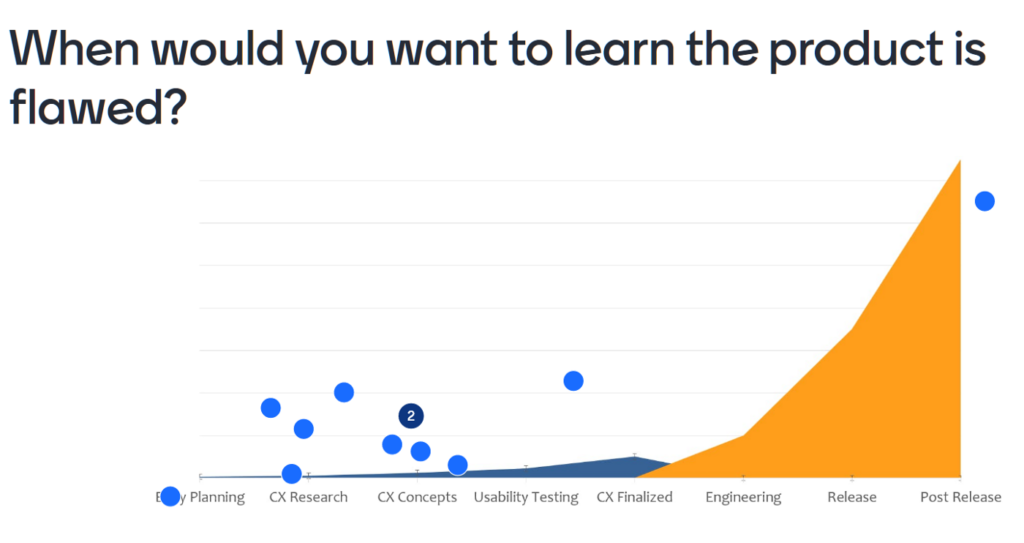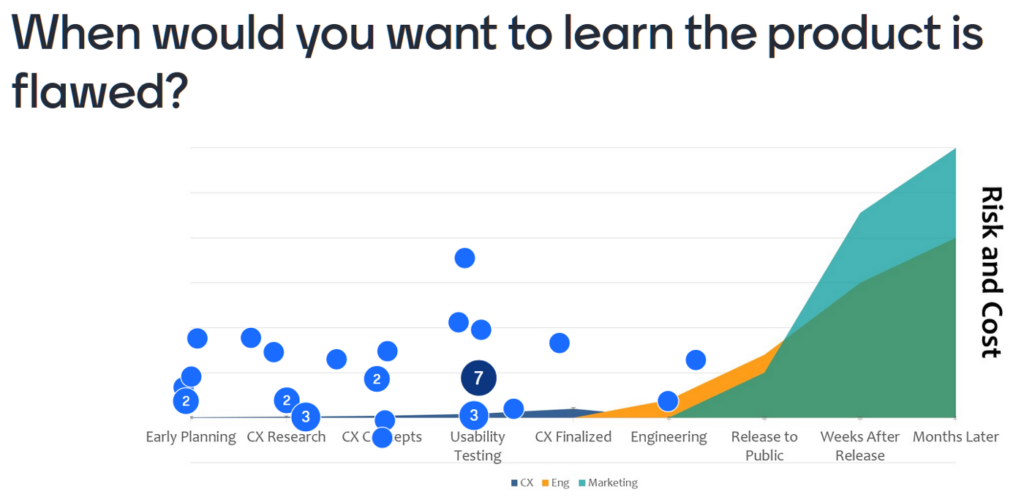UI/UX Designers, UX Designers, and Product Designers are often (but not always) visual designers who make wireframes. They rarely have extensive knowledge of cognitive psychology, human behavior, and the true foundations of User Experience. They rarely have expertise in research. They tend to go by feel or what they think will work or solve a problem. They don’t always do usability testing, especially if the company or teams believe you test concepts after they are released to the public.
Many (but not all) like design thinking, design sprints, so-called Lean UX (which is neither Lean nor UX), and ways that we can get everybody to “do the UX” or “be designers” or “design the product.” The more you have everybody working on the product, the less you have to work on the product. The less there is a spotlight on you if you happen to nor be greta at information architecture, interaction design, problem finding, to problem solving.
They believe that good UX is looking at something, caring about customers, and making something you think might work for them.
Over the next 2 years, this has the power to teach everybody at our workplaces exactly what the message is: UX is easy and everybody can do it. They’re getting the message now, and this will be (and continue to be) reinforced by bootcamps, online courses, and other programs that package “UX” as “care about users, run some workshops, and find a solution.”
I’ll call them UX/UI Designers. And this is where UX and CX will further divide. UX will become the thing everybody can do, mostly in workshops and team exercises. CX will be something done by specialists.
The other group contains CX Researchers, CX Architects, CX Visual Designers, CX Content Strategists, and CX Data Scientists
They’re not going to take orders. They don’t want to be told “we’re ripping off the competition” or “just wireframe Sam’s idea” or “get something ready for Engineering in 2 days” or “hold more workshops.”
They believe in User-Centered Design and Human-Centered Design. They believe in complete customer-centricity, and put it into practice in every phase and every step of every task. It shouldn’t be built (and if it somehow were built, it shouldn’t ship) if it doesn’t match real users’ and customers’ needs, tasks, behaviors, perspectives, and accessibility requirements.
They don’t want to be called “designer” because that seems to go with “make it pretty” or “just tell me where to put that button.” They studied cognitive psychology. They approach projects with strategy, science, and technique. They know that problem finding and solving are about way more than your “mindset” or “thinking”. They are about “doing” but were smart enough to nottry to popularize the phrase “design doing.”
They are looking for respect, autonomy, and more time and budget to do their best work. They don’t want to cut corners. They believe in quality over speed. They are grounded in proper research.
They see the difference between collaboration and approaches that sail past normal collaboration and dock at design by committee, decision by committee, design by workshop, “democratization” (where somehow only CX/UX gets democratized while all the other domains retain their power), and the like. They love collaboration and they reject “by committee” and democratization as not UCD or HCD. Not best for the customers. Not customer-centric. Surprisingly ego-focused on “how might we ________” instead of “how will customers easily ____________.”
They studied, practiced, and integrated UCD, HCD, cognitive psychology, human behavior, and information architecture into their work. If they are into research, they worked to learn more about CX research methods, good and bad questions, techniques, and more. Basically, they are going way way deeper than everybody in online courses and bootcamps. They have mentors and coaches who check their work and help them level up. They never stop learning.
They are change agents. They want to make everything they can better. The customer experience. Internal team processes. This is in their blood.
Wait, what’s the difference between a UI Designer and your CX Visual Designer?
The CX Visual Designer has studied some psych. They have trained on accessibility. They are not going to create a color palette that can’t be used by the colorblind. They are not going to use font sizes that are too small. They are not going to run with neumorphism or any trend that is bad for accessibility. They are not going to design grey on slightly lighter grey. They will consider fonts that work well for dyslexia.
They understand the difference between IA/IxD and “I make wireframes.”
They are change agents. They will utilize great qualitative research in their design approach. They are true CX partners, not a pair of hands adding what I’ve heard called “paint” or “polish” to interaction designs.
People who aren’t interested in the foundations, deep quality, and technique in CX (and I have found many of those) can be called UX/UI Designers. The rest can be called CX Visual Designers.
Everybody’s hung up on titles, right? Let’s start making them mean something
If you have studied psychology and you are obsessed with UCD, HCD, and the customer experience, you will have a CX title. Everybody else can be UX, UI, and Product Something.
These two paths are why there are completely opposite opinions on things that seem obvious to the people on each path
Design thinking, really making companies more empathetic? Or total theater, wasting time and money on fake UX? Design sprints, great for innovation or completely undermining and undervaluing UX? Designing products via workshops, everybody’s a designer, and letting non-CX/UX teammates make decisions in our domain… great for the customer experience or awful for customers, workers, teams, process, etc?
While each of these has plenty of middle ground and grey areas, many people are quite polarized on these. They are deeply for or against these and other Aspirologies. This is another way we know we are on two completely different paths at the same time.
The people who love that Google’s Coursera UX course spends two weeks on “what are some things people in UX do” and then goes right into design sprints are on another planet from the people who can’t believe that a course calling itself “UX” is more focused on design sprints and “self-reflection” than UCD and HCD.
It reminds us that there are two very different definitions of UX that don’t appear to be reconcilable. UX can’t be the thorough science and technique of UCD and HCD done properly by specialists and also be the quickie shortcuts done in team workshops where specialists might not be required or utilized.
I predict that “UX” will come to relate to pretty wireframes and prototypes mostly done by visual designers. There will be lots of team exercises and workshops with various names (that come with various books, training, and certificates). UX will be what our company does when it wants to play startup dress-up and pretend they are in a Silicon Valley garage. Workshops will be plentiful, and will rarely have success criteria or KPIs. If everybody had fun sketching screens, this workshop was awesome.
“CX” will be almost the opposite. It will be educated, knowledgeable, and talented researchers taking weeks or months to bring competitive intelligence and deep customer and market knowledge to the company. It will be processes that reject guessing and assumptions, always opting for researching, testing, and knowing. It will demand people truly skilled in information architecture, accessibility, problem finding, and problem solving. It will require the right success criteria, metrics, and qualitative data to constantly know if we’re headed in the right direction. It will reject the wrong metrics or myopic metrics that often fish for short-term wins that have long-term consequences.
Which means there are and will be two types of companies
There already is a divide. We often talk about low maturity companies and higher maturity companies. If low maturity companies have CX or UX at all, they generally want UX/UI Designers. People who they see as the new production designer who will give them the wireframes they want. UX/UI Designers are assessed (often only) by their portfolio, which will be heavy on visual design but of course have some wireframes and walls of sticky notes.
UX/UI Designers by any name will be (and currently often are) a pair of hands getting wireframes or a prototype to Engineering. These low CX maturity companies are primarily an Engineering-driven org and secondarily a marketing-driven org. Engineering might not even keep the UX/UI people around once they have a design system; engineers might imagine that they just need to put the components on the screen any old way, and it’s a good user experience.
The higher CX maturity companies believe in customer-centricity. They believe in R&D. They believe in R before D. They want to know. They want to reduce the risk that comes from guesses, assumptions, hypotheses, and “we know our customers.“ They don’t believe in creating products that are minimally viable. They believe in using customers’ definitions of “quality” and “done.”
They will hire the CX Researchers, Architects, and others. Their HR processes weed out the UX/UI Designer, Production Designer, and people who like to guess at solutions without a solid UCD process.
High maturity companies are primarily driven by knowledge of customers. Everything else is influenced by that knowledge. Strategies are determined by that knowledge. Initiatives and goals utilize that knowledge. Deep knowledge and understanding of customers isn’t a luxury or a Marketing line item. These companies know it’s business intelligence that can lead them to market domination.
How to tell the two companies apart
In addition to how these companies describe jobs, assess candidates, and include CX/UX in processes and teams, you’ll be able to tell the two types of companies apart by when they “fail fast.”
Here’s me asking an audience of Agile coaches and Scrum masters when they wish they could know if their product is right for customers. (I think the far right dot was placed before they received the instructions. I think they marked when they find out now. But who knows.)

Then I asked something similar when I gave a keynote at a marketing conference.

Low maturity companies might say they want to know early that the product Is going in the wrong direction. But they will ship crappy products and services to customers and call that Agile, Lean, or being “like a startup.” They wait until after release to “test“ the product or get feedback. They’re slow, reactive, and surprised by customers’ reactions. They waste a lot of money shipping guesses and having (or pretending) to fix them later. They “fail fast” really slowly, late in the game, and in the public eye.
High CX maturity companies will stop planning, conceptualizing, engineering, or a release when they know the product is going in the wrong direction. They won’t wait until some or all of the public has to deal with this. They won’t be happy with “we shipped it fast” if it’s not the right execution of the right idea. The failures will be mostly internal versus seen, experienced, and tweeted about in the public eye.
If so many companies fit the first “low maturity” type, where will the CX change agents work?
I predict that faced with awful jobs on awful teams at awful low maturity companies, those falling into my CX Research, Architect, and other CX titles who can’t get that rare job at the high maturity company will leave corporate jobs. They’ll stop applying. Why work at a place where you are nearly immediately a flight risk or trying to quit? They won’t even bother unless the company sends the right signals that they are high maturity and customer-centric.
I predict that within 2 years from now, 90% of CX change agents will be found at agencies and consultancies. 10% will have found a good job at a high CX maturity company. Low maturity companies won’t even be able to hire them full-time. The workplace, processes, and outcomes will be too undesirable.
I predict that low maturity companies will have teams of “UX/UI Designers” or “Product Designers” who like to wireframe and focus on the aesthetics. They are OK taking orders so they can get it done in a sprint or whatever time frame Engineering says they can have. These companies will be overrun with “design thinkers” and “product by workshop.” If anybody can do “UX,” then everybody will take a shot at designing the product. There will be no accountability. If the product fails, it was everybody’s fault equally, and nobody will want to take that blame. So we’ll just spin up another MVP.
That’s where one path is going, and that’s who will be on that path. UX/UI Designers (and whatever title you give them) will be the new Production Designer.
The practitioners doing CX and UX tasks with science, technique, proficiency, critical thinking, and a bizarre ability to see multiple possible outcomes won’t want to work there. People following in the still-visible footsteps of Don Norman will only be found through agencies and consultancies.
And you will call on them when you have done the math and realized how much you’re spending on workshops, mindsets, sticky notes, sketches, guesses, assumptions, hypotheses, and “we’re fast!”
This means there are and will be two kinds of agencies
There are agencies and consultancies who take orders. Gladly. They are very happy to just make wireframes, hand over some pretty designs, and give clients exactly what they ask for. They are unlikely to challenge the client, product, or feature. They’re essentially an outsourced team of UX/UI Production Designers taking orders and not making waves.
They’re not change agents. They don’t reward critical thinking. They often don’t want to invest in problem finding. They just want to take whatever problem the client suggests and find a solution. They often start with workshops, have workshops in the middle, and end with workshops. Design thinking, design sprints, Lean UX… they’re going to trot all of them out. Critical thinking not required.
The agencies that will rise up in the coming years are the change agents. It’s really easy to hire non-change agents. You can find those people everywhere. You won’t need agencies that staff those people and use those approaches. How do you find the really skilled, talented, and scientific specialists? Those will be the agencies and consultancies to look for.
I will call them Change Agencies. That’s where you will want to work. That’s who companies will want to hire.
For the next 2 years…
We will fight it. I will send my new, completely free HR/recruiter/sourcer/hiring manager training to everybody I can, especially those sending me ridiculous jobs I refuse to even apply for.
Those who believe in quality over speed will keep fighting the crappy workplaces, ridiculous jobs, requests for unicorns, and what I call “moving target jobs,” which ask for so many skills that there is no way you’re ever going to work on the right thing at the right time. Someone will keep changing your priorities. You were coding? Where are your wireframes?! You’re working on wireframes? Where is your visual design?! Moving target. You’ve all had that job.
And slowly over the next 2 years, the ones who are fighting will leave those jobs to be freelancers. The freelancers will get together and create agencies. Agencies and consultancies will have more qualified staff than your average Big Name You Know Who I Mean Consultancy. They will have lower pricing and rates than those consultancies. Big Name Consultancies mostly hiring UX/UI Designers will be hired less and less often because they are order takers and yes-sayers versus being critical thinkers and change agents.
Change Agencies will have strong and highly competitive apprenticeship programs. They will create the unbelievably strong Low Ego Action Heroes who will be our seniors in 5 years.
Over in the corporate world, the “UX/UI Designer” production designer will eventually be promoted to a “Senior UX/UI Designer.” And if they make it to manager, they will happily bring in these agencies and consultancies because they will understand where their team’s abilities and capabilities have limits.
That’s where I think this will go
We can keep fighting. We can work to “save” CX and UX. We can try to explain “the value of design” and “reasons to be customer-centric.” If companies aren’t accepting that, they will lose us.
But there’s only so far they can get without us. The customers decide the quality of your product no matter what an Agile coach, Scrum master, product manager, or high-paid person says. Companies who don’t want to release product and service garbage will need CX specialists. If they can’t hire them full-time, they will find another way to include them on mission critical projects.
They will bring us in as agencies and freelancers when they realize that nobody there can do anything close to what we do. CX and UX will be saved, but I don’t see it being a viable full time corporate job again for quite some time. It’s about to be dominated by freelancers, agencies, and consultancies.








